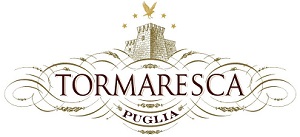Country:
 Italy Region: Apulia
Italy Region: Apulia
Type: White Style: Dry Class: DOC
Drinking: 2018 - 2023
 Chardonnay 90%, Fiano 10% This elegant Chardonnay is produced on the Bocca di Lupo estate in The Murgia region of Apulia. The distinctive characteristic of this area is its “pietra”. The etymology of the word “Murgia” refers sharp stone or rock and makes a specific reference to the dry stonewalls that line the countryside. ""Pietrabianca"" also refers to the stones that rural farmers hit while ploughing the fields and once they were crushed and ground into the soil, helped enhance the flavors of the wines grown there. Rich, complex and at the same time fresh and pleasant, Pietrabianca shows that Apulia is a region of great white wines too.
Chardonnay 90%, Fiano 10% This elegant Chardonnay is produced on the Bocca di Lupo estate in The Murgia region of Apulia. The distinctive characteristic of this area is its “pietra”. The etymology of the word “Murgia” refers sharp stone or rock and makes a specific reference to the dry stonewalls that line the countryside. ""Pietrabianca"" also refers to the stones that rural farmers hit while ploughing the fields and once they were crushed and ground into the soil, helped enhance the flavors of the wines grown there. Rich, complex and at the same time fresh and pleasant, Pietrabianca shows that Apulia is a region of great white wines too.

Passion, courage and trust in the enormous quality potential that Puglia, and especially the areas of Castel del Monte and Salento were able to express, inspired the Antinoris to invest in the region. The idea that, from the start, characterized Tormaresca's production philosophy was to produce great wines from autochtonous varietals. Named for the region’s ancient seaside towers overlooking the Adriatic Sea, Tormaresca adds a fresh dimension to Italy’s world-class wine landscape. Indeed, it is the only producer with vineyards in both of Puglia’s elite winegrowing regions. The Bocca di Lupo estate is located within the Castel del Monte DOC, while the Masseria Maìme estate is in the Salento area, the pulsing heart of this vibrant winemaking region. Tormaresca leads Puglia’s modern renaissance by combining classic winemaking with the latest viticulture techniques to create exceptional wines just waiting to be discovered. All Tormaresca wines are crafted with 100% estate-grown fruit.
|
Il Racconto di Tormaresca Il Racconto di Tormaresca short movie |
|
2011 Bocco di Lupo 2011 Bocco di Lupo Producer Vintage and Tasting Report |
|
2013 Masseria Maime Data Sheet 2013 Masseria Maime Producer Data Sheet |
|
2014 Torcicda Primitivo Salento Rosso Technical Sheet 2014 Torcicda Primitivo Salento Rosso Producer Technical Sheet |
|
2014 Trentangeli Rosso Technical Sheet 2014 Trentangeli Rosso Producer Technical Sheet |
|
2015 PietraBianca Technical Sheet 2015 PietraBianca Producer Technical Sheet |
|
2016 PietraBianca Technical Sheet 2016 PietraBianca Producer Technical Sheet |
- Chardonnay
Chardonnay is the "Big Daddy" of white wine grapes and one of the most widely planted in the world. It is suited to a wide variety of soils, though it excels in soils with a high limestone content as found in Champagne, Chablis, and the Côte D`Or.
Burgundy is Chardonnay's spiritual home and the best White Burgundies are dry, rich, honeyed wines with marvellous poise, elegance and balance. They are unquestionably the finest dry white wines in the world. Chardonnay plays a crucial role in the Champagne blend, providing structure and finesse, and is the sole grape in Blanc de Blancs.
It is quantitatively important in California and Australia, is widely planted in Chile and South Africa, and is now the most widely planted grape in New Zealand. In warm climates Chardonnay has a tendency to develop very high sugar levels during the final stages of ripening and this can occur at the expense of acidity. Late picking is a common problem and can result in blowsy and flabby wines that lack structure and definition.
Recently in the New World, we have seen a move towards more elegant, better- balanced and less oak-driven Chardonnays, and this is to be welcomed. - Fiano
Fiano is a white Italian wine grape variety that is grown primarily in the Campania region of southern Italy and on the island of Sicily. In Campania, this fairly strong flavored white wine grape is particularly noted around Avellino where the Denominazione di origine controllata e Garantita (DOCG) wine of Fiano di Avellino is produced. The grape has a long history in the Campanian region and is believed to have been the grape behind the ancient Roman wine Apianum. Even today, the name Apianum is permitted to appear on wine labels of the DOCG wine Fiano di Avellino.
Outside of Italy, several Australian wine producers have begun to use the grape. Production seems to be increasing, although the number of vineyards growing it is still small. One place of production is in the McLaren Vale wine region of South Australia. More recently, some winemakers in Argentina are producing Fiano in the La Rioja district, north of Mendoza.
Beyond its strong flavors and intense aroma notes, the Fiano grapevine is noted viticulturally for the relatively low yields it produces.
| Who | Score |
Start |
End |
Notes |
|---|---|---|---|---|
| Wine Enthusiast www.winemag.com Apr 2018 |
89/100 | Aromas of citrus, sea spray and toast ride over a riper core of melon on the nose. This is expressive in fruit intensity and weight, offering a silken palate of juicy melon and citrus flavors, balanced by an integrated vein of acidity. A lightly charred lemon note lingers on the finish. |